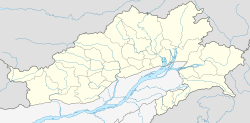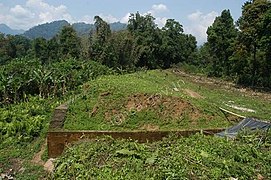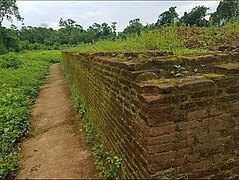ভীষ্মকনগর
 জাদুঘরে সংরক্ষিত ঐতিহাসিক তথ্য | |
| বিকল্প নাম | সাধয়াপুর |
|---|---|
| অবস্থান | নিম্ন দিবাং উপত্যকা জেলা, অরুণাচল প্রদেশ, ভারত |
| স্থানাঙ্ক | ২৮°০২′৪৮.২″ উত্তর ৯৬°০′২০.৭″ পূর্ব / ২৮.০৪৬৭২২° উত্তর ৯৬.০০৫৭৫০° পূর্ব |
| ধরন | বসতি |
| দৈর্ঘ্য | ৪.৫ কিমি |
| প্রস্থ | ২.৫ কিমি |
| ইতিহাস | |
| উপাদান | ইট, পাথর, মাটি |
| প্রতিষ্ঠিত | অষ্টম শতাব্দী |
| পরিত্যক্ত | ষোড়শ শতাব্দী |
ভীষ্মকনগর ভারতের অরুণাচল প্রদেশের একটি প্রত্নতাত্বিক স্থান। এটি নিম্ন দিবাং জেলার রোয়িং এ অবস্থিত।[১] অবশেষগুলিতে সাধারণত দেখানো হয়েছে শুতিয়া নামক বোড়ো-কাছারি জনগোষ্ঠীকে, এরা সাধারণত তিব্বতি-বার্মিজ মানুষ।[২] এই জনগোষ্ঠী একাদশ থেকে ষোড়শ শতকের মধ্যবর্তী সময় সাদিয়া অঞ্চলে শাসন করত।[৩]
নামকরণ[সম্পাদনা]
ভীষ্মকনগর নামটি ১৯২৮ সালে প্রথম অসম ডিস্ট্রিক্ট গ্যাজেটরে প্রকাশিত হয়।[৪][note ১]
ঐতিহাসিকভাবে, অঞ্চলটি সাধয়াপুরা নামে পরিচিত ছিল।[৭] এবং দুর্গটি শুতিয়া রাজা লক্ষ্মীনারায়ণের রাজধানীর অন্তর্গত ছিল,[৮]এটি চে-লুং নামেও পরিচিত যার অর্থ মহানগরী।
অবস্থান[সম্পাদনা]
এটি নিম্ন দিবাং উপত্যকা জেলায় অবস্থিত। পুরান শহরের ক্যাম্পাসটি ২৫০০ একর এলাকা জুড়ে বিস্তৃত।
ইতিহাস[সম্পাদনা]
ভীষ্মকনগর একটি গুরুত্বপূর্ণ প্রাচীন প্রত্নতাত্ত্বিক স্থান। স্থানটি শুতিয়া রাজ্যের একটি শক্তিশালী কেন্দ্র ছিল। ধ্বংসস্তূপের বয়স একাদশ থেকে পঞ্চদশ শতাব্দীর মধ্যে।[৯] ভীষ্মকনগরকে সাধয়াপুরী বা স্বাধয়াপুরী হিসেবে চিহ্নিত করা হয়েছে যা শুতিয়া রাজ্যের রাজনৈতিক কেন্দ্র ছিল।[১০]ইটের উপরের কারুকার্য দেখলে বোঝা যায় এটি পঞ্চদশ শতাব্দীর শুতিয়া রাজা লক্ষ্মীনারায়ণের রাজধানী ছিল। প্রত্নতাত্ত্বিক বিশ্লেষণে এই সময়টিকেই মান্যতা দেওয়া হয়েছে।[১১]
স্থাপত্য[সম্পাদনা]
দুর্গটি এবং সংলগ্ন স্থাপত্য পোড়া ইট দ্বারা তৈরী। দুর্গবেষ্টিত নগরটি ১০ বর্গকিমি অঞ্চল জুড়ে বিস্তৃত। পূর্ব, পশ্চিম ও দক্ষিণ দিকে বিস্তৃত গ্রানাইট ও ইষ্ট-নির্মিত প্রাচীরগুলি ৪.৫ মিটার দীর্ঘ এবং ৬ মিটার চওড়া।[১২][১৩][১৪] উত্তরে মিশমি পাহাড়গুলি প্রাকৃতিক সীমানা।[১৫]
ভীষ্মকনগর সেন্ট্রাল কমপ্লেক্স ১৮৬০ বর্গকিমি অঞ্চল জুড়ে বিস্তৃত ছিল ও ২ মিটার উঁচু পাথরের প্রাচীর রয়েছে। দুর্গের ভাষ্কর্য মধ্যযুগের সংস্কৃতির পরিচায়ক। খনন করার সময়ে প্রচুর টেরাকোটার নিদর্শন পাওয়া গিয়েছে।[১৩]
চিত্রসম্ভার[সম্পাদনা]
-
ভারতীয় প্রত্নতাত্ত্বিক বিভাগের ফলক
-
ভীষ্মকনগরের ইটের স্থাপত্যের একটি অংশ
-
পশ্চিম প্রবেশপথের দিকে দুর্গবেষ্টিত ইষ্টপ্রাচীরের একটি অংশ
-
পূর্ব প্রবেশপথের একটি অংশ
-
পশ্চিম প্রবেশপথের একটি অংশ
-
পূর্ব প্রবেশপথের দিকে দুর্গবেষ্টিত ইষ্টপ্রাচীরের একটি অংশ
-
পশ্চিম প্রাচীরের একটি অংশ
-
প্রধান স্থাপত্যের তিনটি বিভাগ
-
দুর্গবেষ্টিত প্রাচীরের থেকে পৃথক একটি ভাষ্কর্য
-
কেন্দ্রীয় স্থাপত্য
-
শুতিয়া রাজা লক্ষ্মীনারায়ণের নাম খোদাই করা একটি ইট
-
পশ্চিম প্রবেশপথ
-
খাপরা
-
কেন্দ্রীয় স্থাপত্যের একটি বিভাগ
-
মাটির পাত্রে গর্ত
-
ভীষ্মকনগর ধ্বংসস্তূপের ইট
-
পশ্চিম ইষ্টপ্রাচীরের অংশ
-
পশ্চিম প্রাচীরের বিভাগ
-
ভীষ্মকনগরে প্রাপ্ত প্রাচীন কারুকার্য
-
ভীষ্মকনগর কমপ্লেক্স Bhismaknagar complex
-
ভীষ্মকনগর ধ্বংসস্তূপ
-
কেন্দ্রীয় স্থাপত্যের অন্যতম দৃশ্য
তথ্যসূত্র[সম্পাদনা]
- ↑ Among many works of Śankaradeva, the Rukmiṇiharaṇa, the poem of Rukmimi and Krishna, gained considerable popularity in the Sadiya area and influenced its regional identity construction. Rukmiṇī, in this poem, was a daughter of king Bhīṣmaka.[৫]The Bhīṣmaka lineage became a part of the new literary tradition of the region and eventually found its way into the later Chutiya chronicles.[৬]
- ↑ "Bhismaknagar"। Government of Arunachal Pradesh। ১১ জুন ২০১৭ তারিখে মূল থেকে আর্কাইভ করা।
- ↑ The Sutiyas belong to the Bodos, a linguistic group of the Brahmaputra valley, speaking a Tibeto-Burman language and having different cognate groups within them.(Shin 2020, পৃ. 51)
- ↑ http://asiguwahaticircle.gov.in/bhismaknagar.html Remains at Bhismaknagar (ASI official website), "The remains are generally ascribed to he rule of the 'Chutias', a Tibeto-Burmese tribe who ruled over the region of Sadiya from 11th to 16th Century CE."
- ↑ "Again at Bishemnagar or Bishmuknagar, situated near Chipulin village up the Balijan (Sunpura) river and accessible from mile 27 on the Lohit valley road, is the remains of a large fort and settlement. It is supposed to have been built by Raja Bishmook or Bhikrum, Raja of Kundilpur, father of Rukmini."(C. Allen 1928:19)
- ↑ Shin 2020, পৃ. 55।
- ↑ Shin 2020, পৃ. 57।
- ↑ "Furthermore, it is fairly certain from the dates available in the inscriptions that Nandin and Satyanārāyaṇa ruled Sadhayāpurī in the latter half of the fourteenth century, while Lakṣmīnārāyaṇa belonged to the beginning, and Dharmanārāyaṇa to the middle of the fifteenth century. It is also nearly clear that Sadhayāpurī (or Svadhayāpurī) mentioned in the inscriptions is the same as Sadhiyā or Sadiya of later times." (Shin 2020:52)
- ↑ "The ruins of two forts in Lohit district of Arunachal Pradesh are said to be the remains of Bhīṣmaka’s city, viz. Bhismaknagar (sk. Bhīṣmakanagara): one ruin about 16 miles northwest of Sadiya at the foot of the hills between the rivers Dikrang and Dibang is known as the fort of Bhīṣmaka, and the other about 24 miles north of Sadiya between the gorges of those two rivers is believed to be the fort of Śiśupāla. Based on an inscribed brick with the name of Śrī-śrī-Lakṣmīnārāyaṇa, discovered from the ruins of the forts in Bhismaknagar, it is assumed that Chutiya king Lakṣmīnārāyaṇa of the early fifteenth century had his capital in the area. The paleographical analysis of the inscription supports this dating." (Shin 2020:56)
- ↑ Tada, Dutta এবং Deori 2012, পৃ. 8।
- ↑ Momin, Mawlong এবং Qādrī 2006, পৃ. 47।
- ↑ Based on an inscribed brick with the name of Śrīśrī-Lakṣmīnārāyaṇa, discovered from the ruins of the forts in Bhismaknagar, it is assumed that Chutiya king Lakṣmīnārāyaṇa of the early fifteenth century had his capital in the area. The paleographical analysis of the inscription supports this dating (Shin 2020, পৃ. 56)
- ↑ (Gait 1906:16)
- ↑ ক খ Tada 2011, পৃ. 114।
- ↑ Chattopadhyay 1984।
- ↑ A. Raikar 1980, পৃ. 19।
বহিঃসংযোগ[সম্পাদনা]
- Gait, Edward Albert (১৯০৬), A history of Assam, Calcutta, Thacker, Spink & co.
- Shin, Jae-Eun (২০২০)। "Descending from demons, ascending to kshatriyas: Genealogical claims and political process in pre-modern Northeast India, The Chutiyas and the Dimasas"। The Indian Economic and Social History Review। 57 (1): 49–75। এসটুসিআইডি 213213265। ডিওআই:10.1177/0019464619894134।
- Tada, Tage; Dutta, J. C.; Deori, Nabajit (২০১২)। Archaeological Heritage of Arunachal Pradesh। Government of Arunachal Pradesh, Department of Cultural Affairs, Directorate of Research।
- Momin, Mignonette; Mawlong, Cecile A.; Qādrī, Fuz̤ail Aḥmad (২০০৬)। Society and Economy in North-East India (ইংরেজি ভাষায়)। Regency Publications। আইএসবিএন 9788189233402।
- Tada, Tage (২০১১)। Archaeological remains of Arunachal Pradesh up to 16th century (Ph.D.)। Rajiv Gandhi University। hdl:10603/288770।
- A. Raikar, Yashavant (১৯৮০)। Archaeology in Arunachal Pradesh। Directorate of Research, Govt. of Arunachal Pradesh।
- Chattopadhyay, Subid (১৯৮৪)। History and archaeology of Arunachal Pradesh (Ph.D.)। University of Calcutta। hdl:10603/159414।
- C. Allen, B (১৯২৮)। Assam district gazetteers। XI। Baptist Mission Press।























